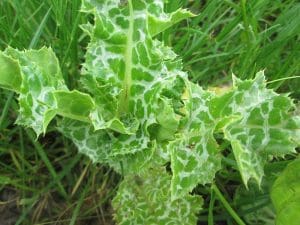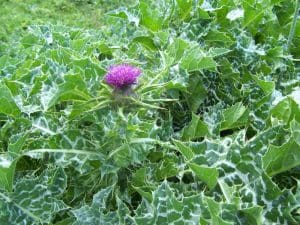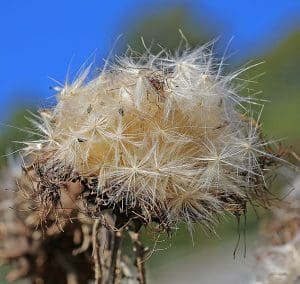Milk Thistle / Spring / Summer / Autumn / Edible
Identification Guide for Milk Thistle
Milk Thistle is an aggressive-looking plant, but with a pair of thick gloves and a little effort you can get plenty of fantastic edible stems & centres from this plant.
Common Names
Holy Thistle, Zebra Thistle, The Spikey Queen
Botanical Name
Silybum marianum
Scientific Classification
Family – Asteraceae
Physical Characteristics for Milk Thistle
This plant is easier to distinguish from other Thistles by the distinctive white veins and marks over the leaves.
A biennial – it grows eventually to between 50cm – 1m 50cm
Leaves
The leaves are oblong in shape with spines around the edge of the leaf and a bowing edge to the leaf. The leaves are hairless apart from up the leaf stem. The initial leaves grow in a rosette from a central point & when it grows larger putting up flowering shoots they grow alternate and have milky-white veins. The upper leaves clasp around the stem.

Flowers
Flowering from July to September – the flowering heads are typically sized between 4 and 12 cm. typically of equal size long and wide. They are light purple in colour.

Fir0002 (talk) (Uploads), CC BY-SA 3.0 <http://creativecommons.org/licenses/by-sa/3.0/>, via Wikimedia Commons
Seeds
Seeding from August to October. The Seeds are similar to those of dandelion seeds but larger.
The umbrella eventually becomes a white puffball of seeds, which can easily be carried for dispersal by the wind.

W. Bulach, CC BY-SA 4.0 <https://creativecommons.org/licenses/by-sa/4.0>, via Wikimedia Commons
Habitat
Often found growing on calerous soil with chalk and rocky bases.
Known Hazards
This plant has the ability to conentrate nitrogen when grown in nitrogen-rich soils and land where fertilisers are used.
Could be Confused with…
Other Thistles but don’t worry all true thistles are edible 🙂
Edible Uses
This plant has a range of different edible uses, it’s one of the species that I like to class as edible & medicinal.
Stems: Use thick gloves to run your hand up the younger stems to remove the spikey outside of the leaves and spines. The remaining shoots can be used a bit like celery stems, they work well pickled, cooked in a tempura batter, steamed, or lightly cooked.
Flowering tops can be peeled and used a bit like artichokes.
The seeds can be collected off of the hairy tops and used a bit like sunflower seeds.
Notes on Herbal Uses
Milk thistle (Silybum marianum, Asteraceae) seeds have been used for over 2000 years as remedy for several diseases especially for liver and are still used widely. The active principle extracted from the seeds is silymarin, which is a mixture of flavonolignans, silibinin (silybin) being the main component, available commercially as standardized extract. the seed extract (silymarin) and its constituents, chiefly silibinin, act as antioxidant and hepatoprotective; effective in treating toxin/xenobiotic poisoning, hepatitis, cirrhosis, and fibrosis of liver; and stimulate liver regeneration. Nevertheless, human studies regarding management of liver diseases are not much compelling. The seed has anti-inflammatory, immunomodulatory, lipid, and biliary effects. It also has antiviral, antitumor, and other health beneficiary properties. Preparations are safe, well-tolerated, and cause no serious adverse effects except mild gastrointestinal and allergic reactions. This seed is a very promising natural drug. More clinical research is warranted to support its wide-ranging health-promoting effects.
See references for a link to research document:
Extra notes from the Foragers
This is one of those plants you could quite easily put off picking as ‘too much effort to harvest’ however when you find a good clump – it grows in big groups, it’s well worth picking as it provides plenty of edible parts and can add a substantial side or even the main event to a dish.







Leave a Reply
You must be logged in to post a comment.